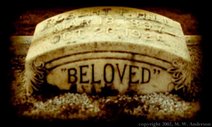'Here,' she said, 'in this place, we flesh; flesh that weeps,
laughs, flesh that dances on bare feet in grass. Love it.
Love it hard. Yonder they do not love your flesh.' (88)
Did I mention that I love Beloved? 12 days left to leave your 5 blog posts...all blog comments for Beloved are due by July 8th, then we'll move on to Invisible Man. I posted a tally as of today on the comments section of the last post. I just finished the book, and was amazed and mesmerized as always happens when I read this book. I've been reading some good criticism, so I'll share some of the questions that scholars have explored (so that you too may examine them) as well as some insights they provided as well. Here's the works cited in case you're interested:
Bloom, Harold, Ed. Modern Critical Interpretations: Beloved. Philadelphia: Chelsea House, 1999.
Notes: *The novel is based on the true story of a runaway slave, Margaret Garner (sound familiar?), who kills her child when she realizes she's about to be captured and returned to slavery under the Fugitive Slave Act (21).
*The name Sethe may be alluding to Lethe, the spring of forgetfulness of Greek mythology (in that Sethe tries but cannot forget the memories that haunt her) (31).
*Morrison states that her "job as a writer in the last quarter of the 20th century, not much more than a hundred years after the Emancipation, becomes how to rip that veil drawn over 'proceedings too terrible to relate'." She dedicated her book to the 60 million and more African Americans who were murdered as a result of slavery. (60 million is the lowest estimation that Morrison found in her research.) 50% of slaves died on the Middle Passage- the slave ships between Africa and America during the slave trade. Toward the end of the novel, when Beloved is describing her journey from the other place, she is described as "crouching" with the dead man on her face. Some scholars contend that she is describing the conditions of the Middle passage, and represents the suffering of an ancestral past, as well as Sethe's trauma (27-28).
Possible Questions to explore:
*In Beloved, who is the Christ-like figure of redemption? The Anti-Christ?
*How is color linked to emotion or lack thereof?
*How does Beloved participate in (and revise) the apocalyptic novel (in which the existing social structure is obliterated)?
*How is Beloved a touchstone in the novel? In other words, how does she reveal each character's core identity/greatest anguish? (Think about: Sethe, Denver, Paul D.)
*Which characters seem to be obsessed with memory? Who attempts to repress the past? Who cannot stop thinking about the past? How successful is each strategy?
*What does Beloved represent?
*How does each character experience a rebirth of sorts? What is the catalyst for change in the novel? What needs to happen in order to move out of the trauma of the past and into hope for the future? (Or, how does psychological healing occur?)
*What is Morrision's vision of community and healing at the end of the novel? Is this truly a story "not to be told" as she states? Why does she say this?
*What is the moment of redemption in the novel?
*What is the connection between the Clearing with Baby Suggs, holy, and the women's song at the end? What is the function and significance of community in the novel?
*Although Sethe's attempt to kill Bodwin is viewed as "crazy," psychologically speaking, how does it illustrate a newfound clarity of mind?
*How are freedom and love linked?
*It is often said that you can't love another if you don't love yourself. In addition, you may not be able to love yourself until you confront the ghosts of your past. How is this true in Beloved?
*Explore the character's emotional lives from beginning to end (Examples: Sethe's "punched out eyes" and Paul D.'s "tobacco tin heart" in the beginning, etc.)
*Sixo says of the thirty-mile woman: "She is a friend of my mind. She gather me, man. The pieces I am, she gather them and give them back to me in all the right order" (272-273). How does the idea of gathering pieces and reconstructing/recreating fit into a larger theme of Beloved?
Wednesday, June 27, 2007
Subscribe to:
Post Comments (Atom)

About Me
- Mrs. Heartz
- Bedford High School English teacher
















3 comments:
Another fun name topic came up in one of my college classes. The name Sethe could be also linked to Seth in the Bible.
According to Genesis 4:25, Seth was born after the slaying of Abel by Cain, and Eve believed God had appointed him as "replacement" for Abel "because Cain killed him". Maybe someone could write about that? Or about the color red? It sure comes up a lot.
I think that Sethe's killing beloved was instane even though she belives it was justified. Today if this situatipn occured a person would be put into a mental hospital and given drugs. to have that much of a bond with a child and kill them off is horrible. and i do belive that murder was not the only option.
Baby Suggs seems to be a savior for the people. She provides them with feasts and emotional support and they rebuke her. The Schoolteacher portrays opposite. throughout the story he causes suffering and nothing more, and the very site of him advocates Sethe to commit a terrible atrocity.
Post a Comment